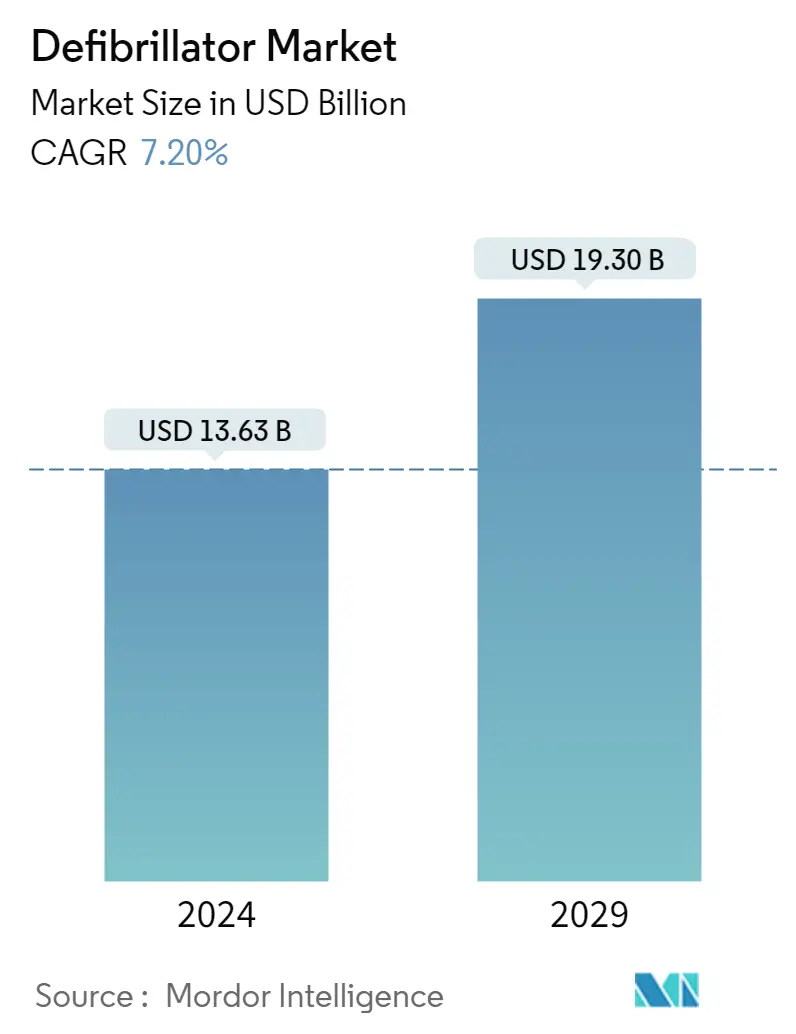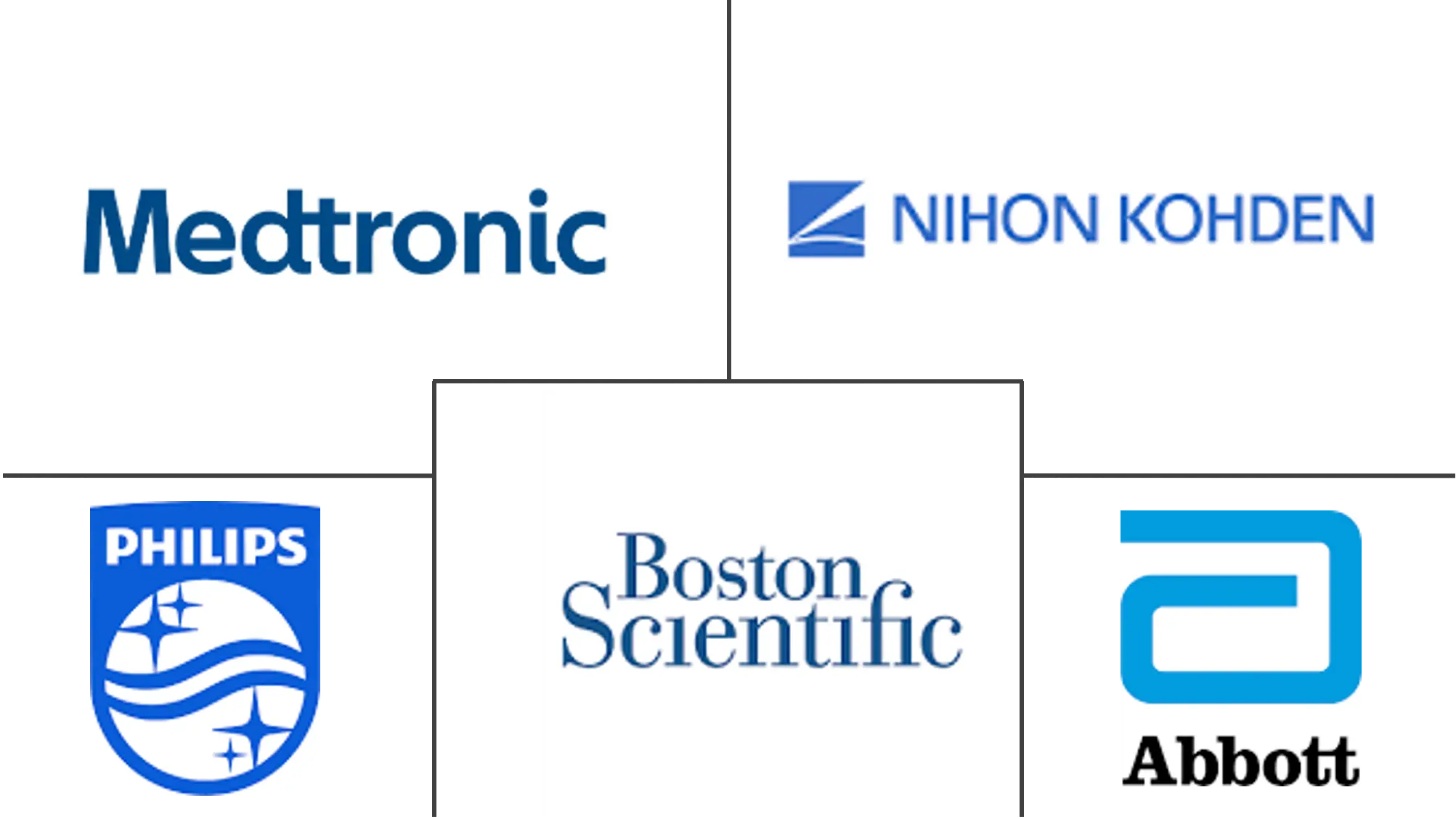Market Size of Defibrillator Industry

| Study Period | 2021 - 2029 |
| Market Size (2024) | USD 13.63 Billion |
| Market Size (2029) | USD 19.30 Billion |
| CAGR (2024 - 2029) | 7.20 % |
| Fastest Growing Market | Asia Pacific |
| Largest Market | North America |
Major Players
*Disclaimer: Major Players sorted in no particular order |
Defibrillator Market Analysis
The Defibrillator Market size is estimated at USD 13.63 billion in 2024, and is expected to reach USD 19.30 billion by 2029, growing at a CAGR of 7.20% during the forecast period (2024-2029).
The COVID-19 epidemic has altered several facets of the healthcare system, including how people are treated for cardiac arrests both outside and within hospitals. There was a reduction in cardiac procedures during the pandemic period due to the strict regulation by various governments across the world. For instance, the EHRA article published in March 2021 mentioned that during the pandemic period, cardiac resynchronization therapy procedures with defibrillation devices decreased by 45%, and procedures involving implantable cardioverter defibrillators were 45% in England. Such reductions in the cardiovascular procedures involving defibrillator devices during the pandemic period had a notable impact on the growth of the market. However, the resumption of all cardiac surgical procedures after the relaxation of strict regulations during the post-pandemic period is expected to contribute to the growth of the market over the forecast period.
The increasing prevalence of cardiovascular diseases and technological advancements in the field of defibrillators are the major drivers for the market. For instance, the British Heart Foundation (BHF) data published in January 2022 reported that the most common heart conditions affected globally were coronary (ischemic) heart disease (global prevalence estimated at 200 million), peripheral arterial (vascular) disease (110 million), stroke (100 million) and atrial fibrillation (60 million). The report also mentioned that the prevalence of heart and circulatory diseases in North America was 46 million, in Europe 99 million, in Africa 58 million, in South America 32 million, in Asia and Australia 310 million. Therefore, the high burden of cardiovascular diseases is expected to contribute to the growing demand for defibrillators as they are widely used in reviving patients from sudden cardiac arrest by providing sufficient oxygen and blood to the required organs via a sudden shock, thereby fueling the growth of the market.
Additionally, the increasing product launches by various governments and various market players are also expected to contribute to the growth of the market. For instance, in February 2022, Infrastructure Minister Nichola Mallon unveiled one of the first life-saving defibrillators that will be installed across the public transport network in Northern Ireland. Additionally, in July 2021, Jeevtronics Pvt Ltd developed SanMitra 100 HCT, the hand-cranked dual-powered defibrillator. The device is affordable, low-weight, and considered more reliable than traditional defibrillators by experts as it can be used even in areas where electricity is unavailable.
However, the stringent regulatory framework is likely to hinder market growth over the forecast period.
Defibrillator Industry Segmentation
As per the scope of the report, a defibrillator is a life-saving device that helps deliver a therapeutic shock to a patient's heart in life-threatening conditions, such as ventricular fibrillation, cardiac arrhythmia, and pulseless ventricular tachycardia. The Defibrillator Market is segmented by Product (Implantable Cardioverter Defibrillator (ICD) (Transvenous Implantable Cardioverter Defibrillator (T-ICDs), Subcutaneous Implantable Cardioverter Defibrillator (S-ICDs), CRT with Pacemaker and ICD Function (CRT-D)) and External Defibrillator (ED) (Automated External Defibrillator (AEDs) (Semi-automated External Defibrillators, Fully-automated External Defibrillators) (Manual External Defibrillator (Wearable Cardioverter Defibrillators (WCDs))), End User (Hospitals, Emergency Care, Home Care, and Other End Users), and Geography (North America, Europe, Asia-Pacific, Middle East and Africa, and South America). The market report also covers the estimated market sizes and trends for 17 different countries across major regions, globally. The report offers the value (in USD million) for the above segments.
| By Product | ||||||
| ||||||
| ||||||
|
| By End User | |
| Hospitals | |
| Emergency Care | |
| Home Care | |
| Other End Users |
| Geography | ||||||||
| ||||||||
| ||||||||
| ||||||||
| ||||||||
|
Defibrillator Market Size Summary
The defibrillator market is poised for significant growth over the forecast period, driven by the increasing prevalence of cardiovascular diseases and advancements in defibrillator technology. The market's expansion is expected to be fueled by the resumption of cardiac procedures post-pandemic, which had previously seen a decline due to stringent regulations. The high global burden of heart conditions, such as coronary heart disease and atrial fibrillation, is anticipated to boost the demand for defibrillators, as these devices are crucial in reviving patients experiencing sudden cardiac arrest. Additionally, the introduction of innovative products and initiatives, such as the deployment of defibrillators in public transport networks and the development of portable, dual-powered devices, are expected to further propel market growth.
North America is projected to hold a substantial share of the defibrillator market, supported by the high prevalence of cardiovascular diseases and the adoption of advanced defibrillator technologies. The region's market growth is also attributed to the presence of major industry players and the development of cutting-edge products to meet increasing demand. The fragmented nature of the market, with numerous global and regional companies, contributes to a competitive landscape where key players like Boston Scientific Corporation and Medtronic PLC are actively involved. Furthermore, awareness campaigns and government initiatives promoting automated external defibrillators are expected to enhance market penetration and adoption, particularly in regions with a high incidence of heart-related conditions.
Defibrillator Market Size - Table of Contents
-
1. MARKET DYNAMICS
-
1.1 Market Overview
-
1.2 Market Drivers
-
1.2.1 Increasing Prevalence of Cardiovascular Diseases
-
1.2.2 Technological Advancements in the Field of Defibrillators
-
-
1.3 Market Restraints
-
1.3.1 Stringent Regulatory Framework
-
-
1.4 Porter's Five Force Analysis
-
1.4.1 Threat of New Entrants
-
1.4.2 Bargaining Power of Buyers/Consumers
-
1.4.3 Bargaining Power of Suppliers
-
1.4.4 Threat of Substitute Products
-
1.4.5 Intensity of Competitive Rivalry
-
-
-
2. MARKET SEGMENTATION (Market Size by Value - USD Million)
-
2.1 By Product
-
2.1.1 Implantable Cardioverter Defibrillator (ICD)
-
2.1.1.1 Transvenous Implantable Cardioverter Defibrillator (T-ICDs)
-
2.1.1.2 Subcutaneous Implantable Cardioverter Defibrillator (S-ICDs)
-
2.1.1.3 CRT with Pacemaker and ICD Function (CRT-D)
-
-
2.1.2 External Defibrillator (ED)
-
2.1.2.1 Automated External Defibrillator (AEDs)
-
2.1.2.1.1 Semi-automated External Defibrillators
-
2.1.2.1.2 Fully-automated External Defibrillators
-
-
-
2.1.3 Manual External Defibrillator
-
2.1.3.1 Wearable Cardioverter Defibrillators (WCDs)
-
-
-
2.2 By End User
-
2.2.1 Hospitals
-
2.2.2 Emergency Care
-
2.2.3 Home Care
-
2.2.4 Other End Users
-
-
2.3 Geography
-
2.3.1 North America
-
2.3.1.1 United States
-
2.3.1.2 Canada
-
2.3.1.3 Mexico
-
-
2.3.2 Europe
-
2.3.2.1 Germany
-
2.3.2.2 United Kingdom
-
2.3.2.3 France
-
2.3.2.4 Italy
-
2.3.2.5 Spain
-
2.3.2.6 Rest of Europe
-
-
2.3.3 Asia-Pacific
-
2.3.3.1 China
-
2.3.3.2 Japan
-
2.3.3.3 India
-
2.3.3.4 Australia
-
2.3.3.5 South Korea
-
2.3.3.6 Rest of Asia-Pacific
-
-
2.3.4 Middle East and Africa
-
2.3.4.1 GCC
-
2.3.4.2 South Africa
-
2.3.4.3 Rest of Middle East and Africa
-
-
2.3.5 South America
-
2.3.5.1 Brazil
-
2.3.5.2 Argentina
-
2.3.5.3 Rest of South America
-
-
-
Defibrillator Market Size FAQs
How big is the Defibrillator Market?
The Defibrillator Market size is expected to reach USD 13.63 billion in 2024 and grow at a CAGR of 7.20% to reach USD 19.30 billion by 2029.
What is the current Defibrillator Market size?
In 2024, the Defibrillator Market size is expected to reach USD 13.63 billion.

